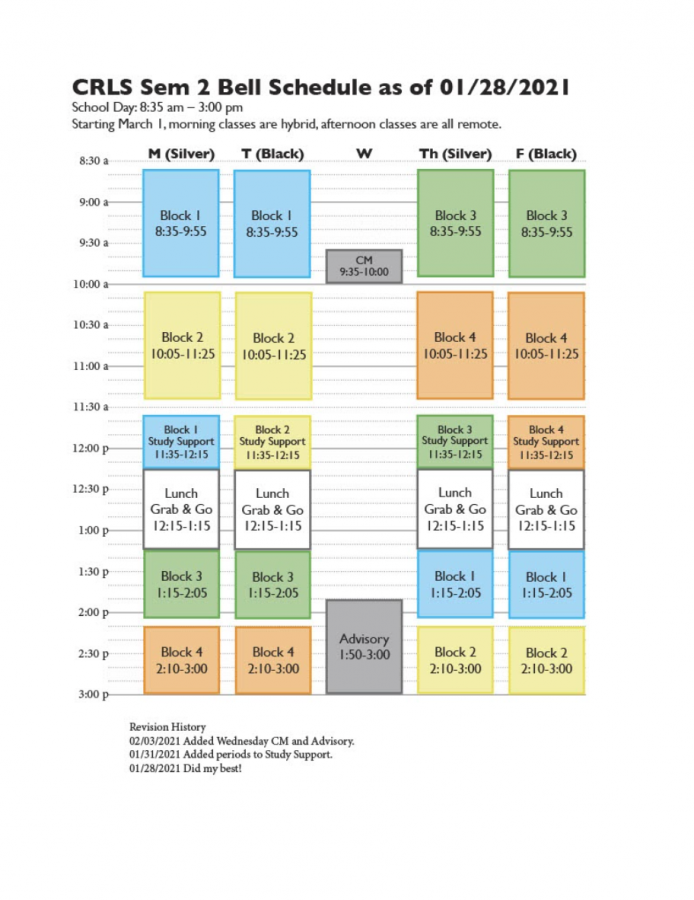CRLS Implements New Second Semester Block Schedule
The new block schedule for the second semester of the CRLS 2020-2021 school year.
February 26, 2021
During the first few days of second semester, students and teachers experienced the new schedule, and there were mixed reviews. While in the first semester there were only 200 required minutes of class (four 50 minute blocks), the new schedule requires 300 minutes of class and a much more complex structure (both times exclude CM and advisory). Classes now start at 8:35 AM—35 minutes earlier than semester one—and end at 3 PM—an hour later than semester one.
In regards to the order of classes, students are required to attend two 80 minute classes and a 40 minute study support before lunch. The two remaining classes each meet after lunch for 50 minutes. On Mondays and Tuesdays, first and second period come before lunch, with third and fourth meeting later in the day. The schedule then flips for Thursday and Friday. Each class has an assigned study support block per week—first period on Monday, second period on Tuesday, and so on. Wednesdays remain mostly asynchronous with the addition of CM and advisory meetings.
With the extra 100 minutes of class per day, students are inevitably spending much more time on their computer. Sophomore Nick Holleran feels the extra time is even affecting him outside of school hours: “I feel increasingly tired and depleted after 3 [PM]. I basically sit on Zoom calls from 8:35 [AM] to 3:00 [PM]. I find myself falling asleep after classes, and just overall feeling super exhausted.” English 10 teacher, Ms. Han Nah Jange, agrees that “Zoom fatigue is real and having more synchronous instructional time in itself is not going to help students absorb the material.” In her mind it would be most effective to shorten the morning blocks.
In his first couple of classes, senior Akale Assayehgen is already noticing that the extended periods are not worth it, and that “most of the teacher’s curriculum have adapted to the 50 min[ute] block, so the extra 30 min[ute]s in class feels like it’s being dragged out.”
One of the main reasons for the change in schedule was to meet the Massachusetts Department of Education’s (DOE) time standards. Even though this was a mandate, statistics teacher, Ms. Alysa Breyer, thinks that the school didn’t take into account what would be most beneficial to the students. Despite this, she remains optimistic: “I think both teachers and students will be more successful during semester two.”
An area of controversy over the change in schedule is the mandatory study support block. What used to be two optional blocks after school has now turned into one mandatory 40 minute meeting before lunch. Not only that, but the study support block of each period coincides with the day the class is already meeting for a long 80 minute block. Every day students are meeting with one of their classes for a total of 120 minutes. Mr. Joseph Nicholson, a Calculus teacher, does prefer the new schedule, but finds that “having study support on a day right after an [80 minute] class with the same group doesn’t really make sense.”
Making the study support blocks mandatory also leaves less time for those who need to get one-on-one time with the teacher. Because of this, many students and teachers feel that the study support block is not going to be as effective.
It is also important to remember that over 600 students opted for in-person learning and will be returning to the building in March. This may change how many perceive the schedule. Only a couple days have passed since the beginning of the new schedule, and like junior Chris Gould says, “I think it’ll take some getting used to. I don’t want to condemn it just yet seeing as we’ve only been doing it for two days.” Giving it a chance may be the main difference between enjoying the remaining few months of school, and not.










